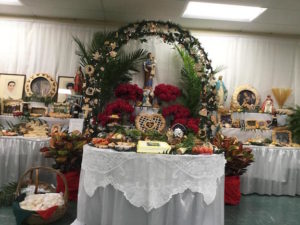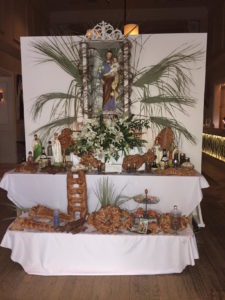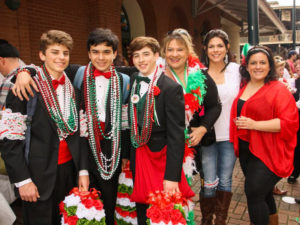
Youth Gathering: Celebrating Your Italian Heritage

We use cookies to help you navigate efficiently and perform certain functions. You will find detailed information about all cookies under each consent category below.
The cookies that are categorized as "Necessary" are stored on your browser as they are essential for enabling the basic functionalities of the site. ...
Necessary cookies are required to enable the basic features of this site, such as providing secure log-in or adjusting your consent preferences. These cookies do not store any personally identifiable data.
Functional cookies help perform certain functionalities like sharing the content of the website on social media platforms, collecting feedback, and other third-party features.
Analytical cookies are used to understand how visitors interact with the website. These cookies help provide information on metrics such as the number of visitors, bounce rate, traffic source, etc.
Performance cookies are used to understand and analyze the key performance indexes of the website which helps in delivering a better user experience for the visitors.
Advertisement cookies are used to provide visitors with customized advertisements based on the pages you visited previously and to analyze the effectiveness of the ad campaigns.

Global Tarantella: Reinventing Southern Italian Folk Music and Dances
Incoronata Inserra, Virginia Commonwealth University

In Global Tarantella (University of Illinois Press, 2017) Incoronata Inserra ventures into the history, global circulation, and recontextualization of tarantella, a genre of Southern Italian folk music and dance. Examining tarantella’s changing image and role among Italians and Italian Americans, Inserra illuminates how factors like tourism, translation, and world music venues have shifted the ethics of place embedded in the tarantella cultural tradition. Once rooted in a world of rural Catholicism, tarantella now thrives in urban, secular, migrant, and ethnic settings. Inserra reveals how the genre’s changing dynamics contribute to reimagining Southern Italian identity and shows how its global growth promotes a reassessment of gender relations in the Italian South, helping create space for Italian and Italian American women to reclaim gendered aspects of the genre.
— Patricia Civitate, Italian-American Cultural Center of Iowa and Director of Il Trattenimento Italiano Folk Dance Troupe
This year marked the 21st anniversary of the St. Joseph Altar Celebration sponsored by the Italian-American Cultural Center of Iowa. This event was successful because of the many hours that numerous volunteers spent making sure that this would be a truly traditional and spiritual undertaking. Sincere thanks to all those who made it happen.

Kathy Foggia and Mary Romanelli began early in February setting up the hall with the backdrop curtains and the three-tiered steps that formed the altar. They covered the steps with linens, attached the table skirts, and then proceeded to add the decorative breads, altar identification cards, and other symbols of faith. John Heldreth and Joseph Boehm donated additional fruits and vegetables and completed the decoration of the altars. Continue reading “St. Joseph Altar Celebration in Des Moines, IA”
IFAFA President Leslie Gigliotti returned home from New Orleans today, but she shared these pictures from an altar that she viewed over the weekend. From Leslie:

Saint Joseph’s day isn’t until Monday, but a hotel here put their altar up earlier this week. Churches, supermarkets, parochial schools, private homes all have viewings. The paper here puts out a listing.
Alligator made of bread and a crayfish too! And traditional wheat design that they showed us in our vestedde class that some of you may have made in the workshop at last fall’s IFAFA Conference in Rockford, IL. Continue reading “From Leslie Gigliotti in New Orleans”
(originally published by Nicole Jankowsky in “The Salt” from NPR <https://www.npr.org/sections/thesalt/2017/03/18/519987433/move-over-st-patrick-st-josephs-feast-is-when-italians-parade>)

March 19th is the Feast Day of St. Joseph, one of the most beloved saints in the Catholic tradition, regarded as the protector of the family. His feast day is celebrated in many ways throughout Italy, but it has a special significance to Sicilians and Sicilian-Americans.

The origin of the celebration dates back to a severe drought which took place in Sicily during the Middle Ages. Crops failed, farm animals died, and famine spread across the island. The Sicilian people turned their prayers to St. Joseph, asking him to intercede on their behalf for relief from the devastating famine, and they promised that, in return, they and their descendants would honor St. Joseph each year on his feast day. Rain came and returned life to the dried land. The disaster was averted, and the Sicilian people gave thanks to St. Joseph with a celebration. The villagers gathered food and placed it on the Continue reading “The Tradition of St. Joseph’s Table”
Zuppa di Lenticchie
Italian Lentil Soup
(as demonstrated and served at the 2017 IFAFA Conference in Rockford, IL)
Lentils are traditionally served at many New Year’s dinners throughout Italy. With their coin-like shape, they are believed to represent good fortune and money in the coming year. They are commonly served with either cotechino or zampone.

1 lb green lentils, rinsed and sorted
3 large yellow onions, chopped
2 leeks, white part only, chopped
1 T minced garlic (3 cloves)
3 T olive oil
salt and black pepper
1 t ground cumin (optional)
8 celery sticks, chopped
4-6 carrots, chopped
3 quarts vegetable or chicken stock
4 T tomato paste
2 T red wine or red wine vinegar (optional)
½ box ditalini (little thimbles) or other small pasta
freshly grated Parmesan cheese (to serve)
In a large stockpot over medium heat, sauté the onions, leeks, and garlic with the olive oil, salt, pepper, and cumin for 20 minutes, until the vegetables are Continue reading “Bring in the New Year with Lentil Soup”
[The Italian version – Natale: la leggenda del panettone – appears at the end of this reading.]
Our beloved panettone, sweet symbol of the Christmas season, has a rather amusing origin. Panettone, as it is understood today, is a recent gastronomical specialty in the history of Italian sweets. In fact, it is said to have been invented only at the end of the 19th century in Milan according to a truly legendary episode.
 As a greeting for a Merry Christmas or Happy New Year, here is the delightful story of the famous panettone. Once upon a time there was a bread-maker named Toni. One fine day, Toni fell madly in love with a certain peasant girl named Lucia. Lucia went to town every morning to sell eggs. Toni, every morning, awaited Lucia’s arrival with longing and enthusiasm, and then, when he saw her, so strong were the feelings that he felt for this young country girl that he never knew what to say and he remained dumbstruck. So many loving glances exchanged, so many sighs, and so many broken eggs, just because this poor devil was unable to express his love. Finally, Toni had a brilliant idea: he decided to prepare a dessert for his adored Lucia, not just any dessert, but a special dessert never made before!
As a greeting for a Merry Christmas or Happy New Year, here is the delightful story of the famous panettone. Once upon a time there was a bread-maker named Toni. One fine day, Toni fell madly in love with a certain peasant girl named Lucia. Lucia went to town every morning to sell eggs. Toni, every morning, awaited Lucia’s arrival with longing and enthusiasm, and then, when he saw her, so strong were the feelings that he felt for this young country girl that he never knew what to say and he remained dumbstruck. So many loving glances exchanged, so many sighs, and so many broken eggs, just because this poor devil was unable to express his love. Finally, Toni had a brilliant idea: he decided to prepare a dessert for his adored Lucia, not just any dessert, but a special dessert never made before!
So, Toni prepared a dessert made with eggs, butter, and candied fruit in a Continue reading “Christmas: The Legend of Panettone”
Look for squid that has already been cleaned to shorten prep time considerably. The squid used for the recipe should be 4-6 inches long. Anything smaller makes for tedious stuffing. Serves 4.

1 ½ pounds cleaned whole squid, including tentacles (Separate squid bodies from tentacles; finely chop tentacles)
½ fresh grated Pecorino Romano cheese
3 tablespoons fresh chopped parsley
Continue reading “Calamari al Forno – Baked Squid”
— by Leslie Gigliotti
Although Christmas is commonly viewed as a commercial holiday, for many families it is still a religious holiday steeped in tradition. This is especially true for the Italian-American population. In Italy, it is often said, Natale con i tuoi, Pasqua con chi vuoi (Christmas with your family, Easter with whomever you wish). One of the many family traditions, alongside decorating the tree and attending midnight mass, is preparing seven types of fish dishes for the Christmas Eve meal.
 The tradition of the seven fishes prepared for meals on Christmas Eve lends itself to a Central and Southern Italian tradition and is not prevalent in the Northern region. Some argue that this may be due to Southerners being a bit more superstitious than their Northern counterparts. Of course, you don’t have to look too far for an explanation of why fish is an obvious choice on Christmas Eve: Catholic rules prohibit the consumption of meat on Christmas Eve.
The tradition of the seven fishes prepared for meals on Christmas Eve lends itself to a Central and Southern Italian tradition and is not prevalent in the Northern region. Some argue that this may be due to Southerners being a bit more superstitious than their Northern counterparts. Of course, you don’t have to look too far for an explanation of why fish is an obvious choice on Christmas Eve: Catholic rules prohibit the consumption of meat on Christmas Eve.
But, like many traditions, the Christmas Eve fish dish has many explanations. There are several arguments provided as to why there are seven fishes consumed, rather than say, six, or even ten. Some reasons are overtly religious: seven gifts of the Holy Spirit; seven sins: pride, envy, anger, gluttony, sloth, lust and greed; seven sacraments of the Church: baptism, penance, Holy Eucharist, Continue reading “A Christmas Eve Tradition”